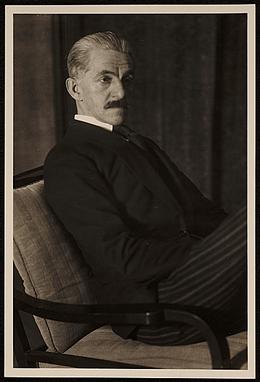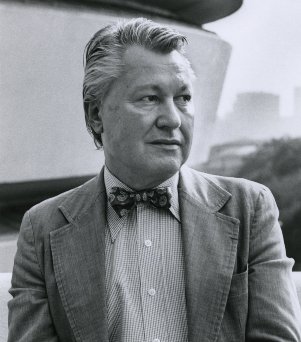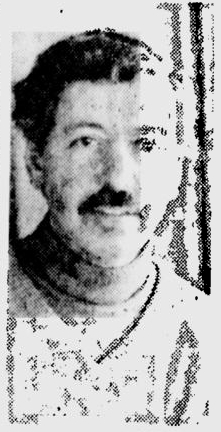Career from 1973 to 2008
After graduating, Armstrong first sought work as a freelance journalist, but he was soon given a one-year internship at the Whitney Museum of American Art's independent study program. To earn enough money to live in New York, he worked as a studio assistant for artists Al Held and Nancy Graves. In 1974, the Whitney hired him to work with curator Marcia Tucker, who, the following year, encouraged him to take a curator position in California at the La Jolla Museum of Contemporary Art. In 1980, Armstrong joined a committee to help organize the new Museum of Contemporary Art, Los Angeles. [1]
He returned to the Whitney in 1981, initially as instructor in the independent study program, and he soon became a curator, developing exhibitions and working directly with artists. [3] There, he organized four biennials, as well as exhibitions on Richard Artschwager and Alexis Smith and the exhibition The New Sculpture 1965–75. In 1992, he moved to Carnegie Museum of Art in Pittsburgh, Pennsylvania, as Curator of Contemporary Art, where he again focused on collaborating with living artists, which he believes is an essential part of the mission of a contemporary art museum. He raised more than $50 million for the museum and expanded its collection of contemporary art. He was appointed chief curator in 1995 and director of the museum in 1996. [1] [3]
Guggenheim
Armstrong was appointed director of the Solomon R. Guggenheim Museum and Foundation in November 2008. His curatorial background contrasted with the business background of his controversial predecessor, Thomas Krens. [1] Recalling the goal of the Guggenheim's first director, Hilla von Rebay, to create a "temple of the spirit", Armstrong stated early in his tenure at the Guggenheim: "We need to expand on the original optimism and taste for the utopian that guided the museum in its beginnings [while making] sure the parts [of the foundation's global collection] are conjoined and working in harmony with one another." [1]
In addition to overseeing the activities of all of the foundation's museums, and in particular the New York collection, Armstrong coordinateed the foundations' acquisitions and scholarship, and its loan exhibitions and collaborations with other museums to foster public outreach. [4] A 2009 retrospective of Frank Lloyd Wright at the New York museum showcased the architect on the 50th anniversary of the opening of the building and was the museum's most popular exhibit since it began keeping such attendance records in 1992. [5] Under Armstrong, Foundation projects included YouTube Play. A Biennial of Creative Video; the BMW Guggenheim Lab, a travelling exhibition, forum and experiment focused on urban living; [4] the Guggenheim UBS MAP Global Art Initiative, to work with curators from around the world to identify and acquire artworks from Asia, South America, the Middle East and Africa; [6] and a collaboration with the Robert H.N. Ho Family Foundation to commission and exhibit works by Chinese-born artists. [7] Many of these projects were focused on broadening the geographical scope of the museums' collection and activities. Armstrong commented in 2012: "We are hoping to challenge our Western-centric view of art history." [6] Exhibitions at the Guggenheim Museum in New York under Armstrong included Kandinsky (2009), [8] Chaos and Classicism: Art in France, Italy, and Germany, 1918–1936 [9] and Maurizio Cattelan: All (2011). [10]
Armstrong served, during this period, in an advisory capacity on several foundation boards, including the Victor Pinchuk Foundation, Kyiv, Ukraine; the Artistic Council, Beyeler Foundation, Basel, Switzerland; the Al Held Foundation, New York City; and the Judd Foundation. He is a director of the Fine Family Foundation, Pittsburgh. He was also a member of the Association of Art Museum Directors. [11]
Armstrong left the museum in late 2023. [12]

The Solomon R. Guggenheim Museum, often referred to as The Guggenheim, is an art museum at 1071 Fifth Avenue between 88th and 89th Streets on the Upper East Side of Manhattan in New York City. It hosts a permanent collection of Impressionist, Post-Impressionist, early Modern, and contemporary art and also features special exhibitions throughout the year. It was established by the Solomon R. Guggenheim Foundation in 1939 as the Museum of Non-Objective Painting, under the guidance of its first director, Hilla von Rebay. The museum adopted its current name in 1952, three years after the death of its founder Solomon R. Guggenheim. It continues to be operated and owned by the Solomon R. Guggenheim Foundation.

The Solomon R. Guggenheim Foundation is a nonprofit organization founded in 1937 by philanthropist Solomon R. Guggenheim and his long-time art advisor, artist Hilla von Rebay. The foundation is a leading institution for the collection, preservation, and research of modern and contemporary art and operates several museums around the world. The first museum established by the foundation was The Museum of Non-Objective Painting, in New York City. This became The Solomon R. Guggenheim Museum in 1952, and the foundation moved the collection into its first permanent museum building, in New York City, in 1959. The foundation next opened the Peggy Guggenheim Collection in Venice, Italy, in 1980. Its international network of museums expanded in 1997 to include the Guggenheim Museum Bilbao in Bilbao, Spain, and it expects to open a new museum, Guggenheim Abu Dhabi, in the United Arab Emirates after its construction is completed.

The Peggy Guggenheim Collection is an art museum on the Grand Canal in the Dorsoduro sestiere of Venice, Italy. It is one of the most visited attractions in Venice. The collection is housed in the Palazzo Venier dei Leoni, an 18th-century palace, which was the home of the American heiress Peggy Guggenheim for three decades. She began displaying her private collection of modern artworks to the public seasonally in 1951. After her death in 1979, it passed to the Solomon R. Guggenheim Foundation, which opened the collection year-round from 1980.

Hildegard Anna Augusta Elisabeth FreiinRebay von Ehrenwiesen, known as Baroness Hilla von Rebay or simply Hilla Rebay, was an abstract artist in the early 20th century and co-founder and first director of the Solomon R. Guggenheim Museum. She was a key figure in advising Solomon R. Guggenheim to collect abstract art, a collection that would later form the basis of the Solomon R. Guggenheim Museum collection. She was also responsible for selecting Frank Lloyd Wright to design the current Guggenheim museum, which is now known as a modernist icon in New York City.
Walter "Chico" Hopps was an American museum director, gallerist, and curator of contemporary art. Hopps helped bring Los Angeles post-war artists to prominence during the 1960s, and later went on to redefine practices of curatorial installation internationally. He is known for contributing decisively to “the emergence of the museum as a place to show new art.”

Alexander Georg Rudolf Bauer was a German-born painter who was involved in the avant-garde group Der Sturm in Berlin, and whose work would become central to the non-objective art collection of Solomon R. Guggenheim.

The Guggenheim Abu Dhabi is a planned art museum, to be located in Saadiyat Island cultural district in Abu Dhabi, United Arab Emirates. Upon completion, it is planned to be the largest of the Guggenheim museums. Architect Frank Gehry designed the building. After announcing the museum project in 2006, work on the site began in 2011 but was soon suspended. A series of construction delays followed; the museum is expected to be completed in 2025.

Thomas Krens is the former director and Senior Advisor for International Affairs of the Solomon R. Guggenheim Foundation in New York City. From the beginning of his work at the Guggenheim, Krens promised, and delivered, great change, and was frequently in the spotlight, often as a figure of controversy.

The Deutsche Guggenheim was an art museum in Berlin, Germany, open from 1997 to 2013. It was located in the ground floor of the Deutsche Bank building on the Unter den Linden boulevard.
Jack Albert Youngerman was an American artist known for his constructions and paintings.
Nancy Spector is an American museum curator who has held positions at the Solomon R. Guggenheim Museum in New York City and the Brooklyn Museum.

Thomas Maria Messer was the director of the Solomon R. Guggenheim Foundation, including the Solomon R. Guggenheim Museum in New York City and the Peggy Guggenheim Collection in Venice, Italy, for 27 years, a longer tenure than any other director of a major New York City arts institution.

Daniel J. Robbins was an American art historian, art critic, and curator, who specialized in avant-garde 20th-century art and helped encourage the study of it. Robbins' area of scholarship was on the theoretical and philosophical origins of Cubism. His writings centered on the importance of artists such as Albert Gleizes, Jean Metzinger, Henri Le Fauconnier and Jacques Villon. He was a specialist in early Modernism, writing on Salon Cubists and championed contemporaries such as Louise Bourgeois and the Color Field painters. Art historian Peter Brooke referred to Robbins as "the great pioneer of the broader history of Cubism".

Matthew Joseph Williams Drutt is an American curator and writer who specializes in modern and contemporary art and design. Based in New York, he has owned and operated his independent consulting practice Drutt Creative Arts Management (DCAM) since 2013l. He is currently working with the Lee Ufan Foundation in Arles on an exhibition of non-objective art foor Fall 2024. More recently, he worked with the Nationalmuseum Stockholm on an exhibition and publication of modern and contemporary American crafts gifted from artists and collectors in the United States to the museum, originally organized by his mother, Helen Drutt. He has worked more recently with the Eckbo Foundation in Oslo on the first major monograph of Thorwald Hellesen published in English and Norwegian in by Arnoldsche Art Publishers. He is currently also developing several other titles with the publisher. Formerly, he worked with the Beyeler Foundation in Switzerland (2013–2016) and the State Hermitage Museum in Russia (2013–2014), consulting on exhibitions, publications, and collections. He continues to serve as an Advisory Curator to the Hermitage Museum Foundation Israel. In 2006, the French Government awarded him the Chevalier de l'Ordre des Arts et des Lettres, and in 2003, his exhibition Kazimir Malevich: Suprematism won Best Monographic Exhibition Organized Nationally from the International Association of Art Critics.
The Guggenheim UBS MAP Global Art Initiative was a five-year program, supported by Swiss bank UBS in which the Solomon R. Guggenheim Foundation identified and works with artists, curators and educators from South and Southeast Asia, Latin America, and the Middle East and North Africa to expand its reach in the international art world. For each of the three phases of the project, the museum invited one curator from the chosen region to the Solomon R Guggenheim Museum in New York City for a two-year curatorial residency, where they worked with a team of Guggenheim staff to identify new artworks that reflect the range of talents in their parts of the world. The resident curators organized international touring exhibitions that highlight these artworks and help organize educational activities. The Foundation acquired these artworks for its permanent collection and included them as the focus of exhibitions that open at the museum in New York and subsequently traveled to two other cultural institutions or other venues around the world. The Foundation supplemented the exhibitions with a series of public and online programs, and supported cross-cultural exchange and collaboration between staff members of the institutions hosting the exhibitions. UBS reportedly contributied more than $40 million to the project to pay for its activities and the art acquisitions. Foundation director Richard Armstrong commented: "We are hoping to challenge our Western-centric view of art history."
June Yap is a Singaporean curator, art critic, and writer. She is currently the Director of Curatorial & Collections at the Singapore Art Museum.
Alexandra Munroe is an American curator, Asia scholar, and author focusing on art, culture, and institutional global strategy. She has produced over 40 exhibitions and published pioneering scholarship on modern and contemporary Asian art. She organized the first major North American retrospectives of artists Yayoi Kusama (1989), Daido Moriyama (1999), Yoko Ono (2000), Mu Xin (2001), Cai Guo-Qiang (2008), and Lee Ufan (2011), among others, and has brought such historic avant-garde movements as Gutai, Mono-ha, and Chinese conceptual art, as well as Japanese otaku culture, to international attention. Her project Japanese Art after 1945: Scream Against the Sky (1994) is recognized for initiating the field of postwar Japanese art history in North America. Recently, Munroe was lead curator of the Guggenheim’s exhibition, Art and China after 1989: Theater of the World, which the New York Times named as one of 2017’s top ten exhibitions and ARTnews named as one of the decade’s top 25 most influential shows. Credited for the far-reaching impact of her exhibitions and scholarship bolstering knowledge of postwar Japanese art history in America and Japan, she received the 2017 Japan Foundation Award and the 2018 Commissioner for Cultural Affairs Award, both bestowed by the government of Japan.
Christine Y. Kim is an American curator of contemporary art. She is currently the Britton Family Curator-at-Large at Tate. Prior to this post, Kim held the position of Curator of Contemporary Art at the Los Angeles County Museum of Art. Before her appointment at LACMA in 2009, she was Associate Curator at The Studio Museum in Harlem in New York. She is best known for her exhibitions of and publications on artists of color, diasporic and marginalized discourses, and 21st-century technology and artistic practices.
Karole P. B. Vail is an American museum director, curator and writer. Since 2017, she has been the director of the Peggy Guggenheim Collection in Venice and Solomon R. Guggenheim Foundation Director for Italy. Prior to this appointment, she worked on the curatorial staff at the Solomon R. Guggenheim Museum in New York for 20 years.

Harriet Korman is an American abstract painter based in New York City, who first gained attention in the early 1970s. She is known for work that embraces improvisation and experimentation within a framework of self-imposed limitations that include simplicity of means, purity of color, and a strict rejection of allusion, illusion, naturalistic light and space, or other translations of reality. Writer John Yau describes Korman as "a pure abstract artist, one who doesn’t rely on a visual hook, cultural association, or anything that smacks of essentialization or the spiritual," a position he suggests few post-Warhol painters have taken. While Korman's work may suggest early twentieth-century abstraction, critics such as Roberta Smith locate its roots among a cohort of early-1970s women artists who sought to reinvent painting using strategies from Process Art, then most associated with sculpture, installation art and performance. Since the 1990s, critics and curators have championed this early work as unjustifiably neglected by a male-dominated 1970s art market and deserving of rediscovery.












